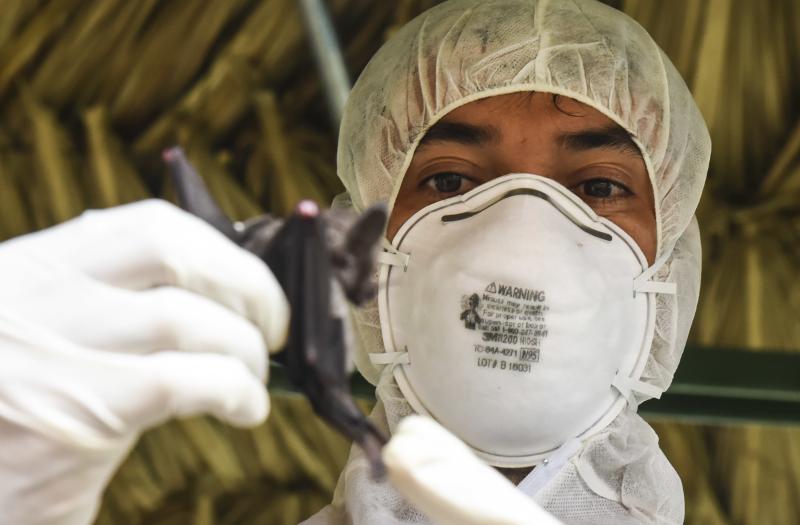Where We Work
See our interactive map


Publio Gonzalez, a biologist with the Gorgas Institute, holds a bat in Meteti, Panama, June 6, 2018, as part an Emerging Infectious Diseases Training Event (U.S. Air Force photo by Senior Airman Dustin Mullen).
How should the public health community react to coronavirus?
A disease spillover event, when a virus moves from animal to human hosts, can cause significant human illness. The coronavirus (COVID-19) seems to have spilled over sometime in late 2019, at a wildlife market in Wuhan, China, leading to more than 40,000 confirmed cases and at least 910 reported deaths by the latest count—in China and at least 25 other countries. The World Health Organization has declared COVID-19 a public health event of international concern, reflecting an escalating sense of urgency at the global level.
How should the public health community react, especially public health policy makers in developing nations?
An oft-quoted precept in disaster management is that the quality of response reflects the level of preparedness. Put another way, a major event is like a light switch: when that switch is turned on, the situation moves instantly from preparedness to response. There is no time left to develop plans, run drills, find supplies, or train personnel. But does this mean that it’s too late for unprepared or under-prepared countries to take action on COVID-19?
No. While it would obviously be preferable to have robust, updated, implementable preparedness and response plans in place—executed by trained personnel at national and subnational levels—the way the COVID-19 virus is playing out provides a window of opportunity to dust off existing preparedness and response plans or use existing toolkits to create operational-level COVID-19 plans.
Importantly, this updating can be done quickly, and will result in a faster, more efficient response when the outbreak crosses the border. By examining our preparedness and response plans, we can ensure that they contain the lessons learned from prior events, can be operationalized, and are tailored to what we are learning about COVID-19.
At DAI, we know first-hand that preparedness and response planning is challenging, particularly in resource-poor settings. Administrators and over-burdened health staff are often tasked with such planning while simultaneously trying to address routine health issues that already strain the health system. Facing chronically unmet health needs, many lower-middle-income countries struggle to achieve adequate preparedness.
DAI has worked in 40 countries in Africa and Southeast Asia on preparedness and response planning in resource-poor environments. Through the U.S. Agency for International Development’s Preparedness and Response (P&R) project, we developed a Preparedness and Response Toolkit for Public Health Events of Unknown Etiology. The toolkit is designed to confront new or emerging disease events just like COVID-19. It promotes a One Health approach (linking human, animal, and environmental health) and a focus on operationally oriented, implementable plans. It contains planning guidance, templates, and worksheets across eight technical areas, including surveillance, coordination and management, rapid response, resource mapping and mobilization, and risk communication.
Even if COVID-19 turns out to be less deadly than some of the more apocalyptic scenarios in the media, health professionals and government planners would be wise to assume it will make its way to their door, resulting in scattered but manageable outbreaks. We have learned a great deal from recent experience in low-resource settings that should inform their planning. The Ebola outbreaks in West Africa, for example, shed light on new approaches to isolation of the sick, the imperative to provide life-saving routine health services even while managing epidemic cases, the importance of scaled-up case detection, the need for early action at the subnational level, and the critical importance of culturally sensitive efforts to build community trust and engagement.
At the same time, new technologies have emerged that enhance diagnostic lab testing, vaccine development, and information management. Many countries now have up-to-date emergency operations centers and public health institutes. All of these new capabilities must be incorporated into country plans. Countries that can quickly absorb the lessons of our recent past—of Ebola, SARS, MERS, H1N1—will be better prepared to detect, mitigate, and contain COVID-19.
Finally, a word on communication. Any large outbreak of a lethal disease is terrifying to the public, yet their participation is essential if we are to conduct effective case detection, social distancing, community disinfection, healthcare triage, and other aspects of a comprehensive response. The communication section of the Toolkit is designed to immediately help countries develop and carry out risk communication activities. Keeping the public calm and winning people’s cooperation with response efforts begins with identifying effective communicators and providing credible, accurate, and timely information before and throughout the crisis.
In sum, effective outbreak response happens because of the public, not despite it, and the toolkit will help you plan how to get them on board.
The piece was originally published on February 11, 2020, on DAI Developments.
Get the latest updates from the blog and eNews




